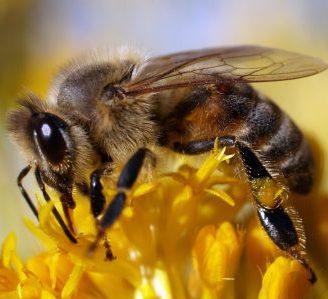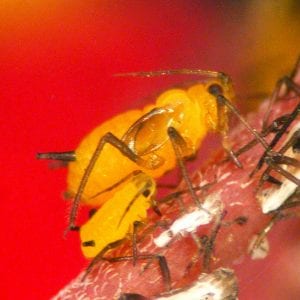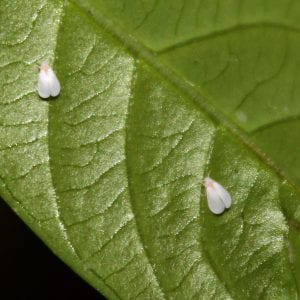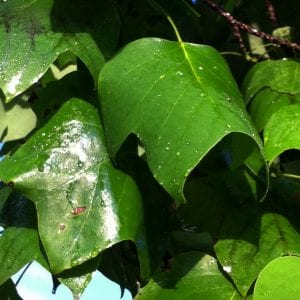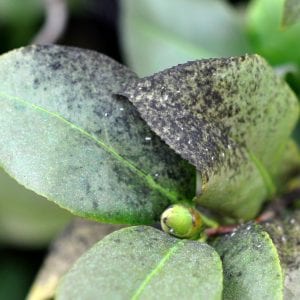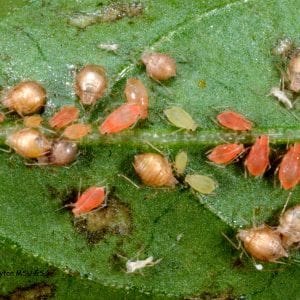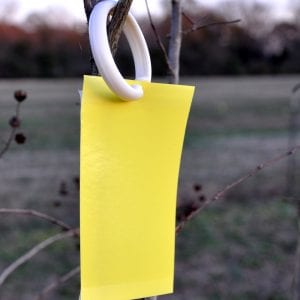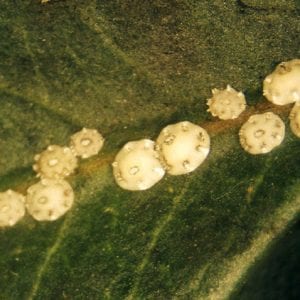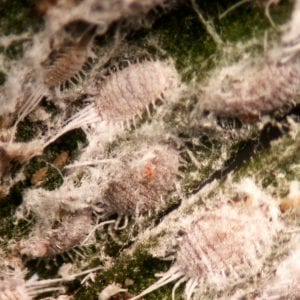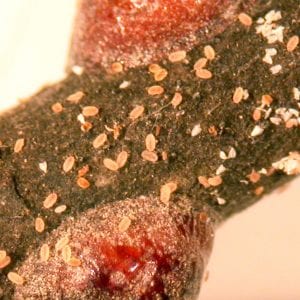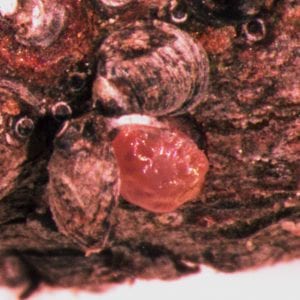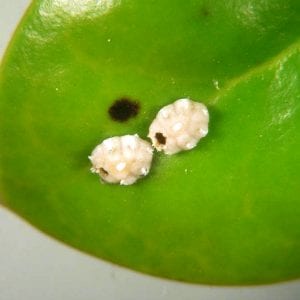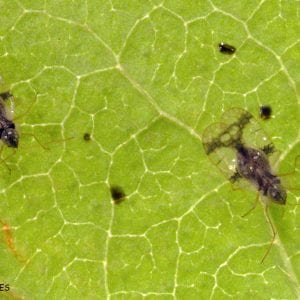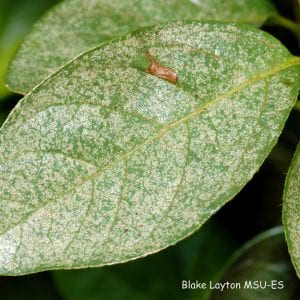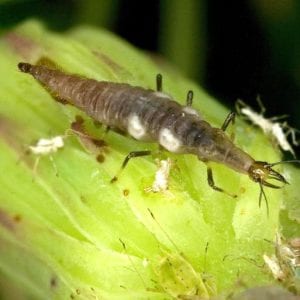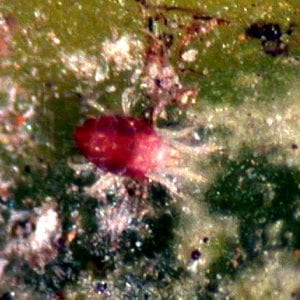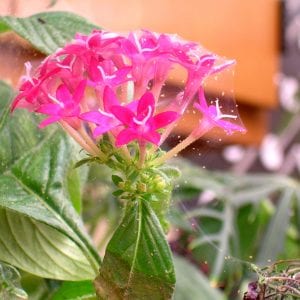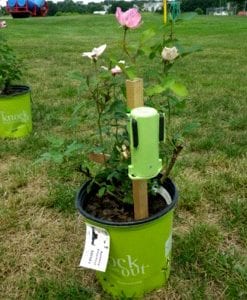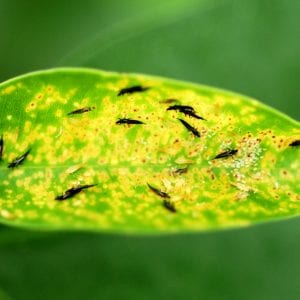Bees & Pollinators

The fourth in the Protecting Pollinators in Urban Areas series focuses on Integrated Pest Management (IPM) approaches to landscaping and pest management from a conservation perspective. The emphasis is on methods that can eliminate pest insects while safeguarding pollinators.
The concept of IPM has been around since the 1960s, but its application remains confusing to many people. It is sometimes misinterpreted as not spraying or using only organic approaches. In its simplest form, IPM involves the use of multiple tools to manage pests. There are three common controls: biological, cultural, and chemical (only when needed).
Chemical Insecticides
Insecticides, especially neonicotinoid varieties, are important IPM tools for management and control of insect pests on turf and ornamental plants. In recent years, however, neonicotinoid insecticides, such as imidacloprid, dinotefuran, thiamethoxam, and clothianidin, have been shown to adversely affect pollinators when residues exceed certain levels. This is true for many, if not most, insecticides. This does not mean that insecticides cannot be used safely; rather, they must be used in a way that prevents pollinators from being exposed to excessive levels of the active ingredient.
In response to scientific findings, several significant revisions have been made to pesticide labels in order to minimize adverse impacts to pollinators. These include placement of the bee hazard icon and other pollinator protection cautions on the labels of certain formulations of neonicotinoid insecticides; restrictions on maximum use rates and number of applications; prohibitions against applying certain neonicotinoid insecticides as foliar sprays to plants that are in bloom; and other instructions for safe use.
When neonicotinoid insecticides are used, there are many measures pest managers can take to limit exposure and risks to pollinators. These mitigation measures are equally applicable when using non-neonicotinoid insecticides:
- Do not apply foliar sprays to plants in bloom if the label prohibits such use.
- Maintain good weed control in turf to prevent the presence of blooming weeds.
- Mow turf grass to remove blooms before treating.
- Apply neonicotinoid treatments to soil after plants have finished blooming.
- Avoid excessive application rates.
- Do not reapply treatments more often than the label allows.
- Avoid preventive treatments unless there is a reasonable probability that a serious pest outbreak will occur in their absence.
- Take all appropriate precautions to avoid off-site drift or movement.
In many cases, neonicotinoids remain the treatment of choice in terms of safety to applicators, to other people using the site post-treatment, to vertebrate wildlife, and to pollinators. Other reasons for their use include environmental impacts, effectiveness against target pest(s), and ease of application.
IPM for Common Pests to Ornamentals
Landscaping with trees, shrubs, and plants adds ecological and aesthetic value to your home. It also can invite insect pests that are attracted to the leaves and flowers as a food source. How do you eliminate the pests while protecting the pollinators? First, you need to know what the pest is. Then you can apply the appropriate IPM techniques to reduce reliance on pesticides as the primary pest management method.
The section that follows describes some of the most common insect pests you may encounter. For each species, alternative insecticides, biological controls, and cultural controls are suggested that you can implement as part of an IPM plan.
Aphids and Whiteflies
Aphids (fig. 1) and whiteflies (fig. 2) are small insects that feed on plant sap with their sucking mouthparts. They are commonly found on the underside of plant leaves.
As a result of feeding on plant sap, which is high in sugar content and low in protein, they produce sugary, watery excrement called honeydew (fig. 3) that can coat the leaves and stems of plants and the ground below. Honeydew provides a media for sooty mold fungi to grow. Sooty mold fungi (fig. 4) do not attack the plant but can cause plants to look horrible. Aphids and whiteflies are often controlled in order to prevent honeydew and sooty mold from staining trees, shrubs, cars, patio furniture, and sidewalks.
- Figure 1. Aphids feed on plant sap and are commonly found on the underside of plant leaves.
- Figure 2. Like aphids, whiteflies fee on plant sap and are typically found on the underside of plant leaves.
- Figure 3. The sugary, watery excrement produced by aphids and whiteflies is known as honeydew. It can coat the leaves, stems, and found below plants.
- Figure 4. Sooty mold fungi do not attach plants but can cause them to look horrible. I can also stain trees, shrubs, cars, patio furniture, and sidewalks.
Aphids and whiteflies develop better on plants that are well watered and well fertilized. They can have multiple generations per year, and populations can build up over time. Overfertilization can help aphid populations increase quickly, so be aware of fertilizer use rates when plants are actively growing.
Checking for Natural Enemies
- Look for signs that natural enemies are present: pupal cases, larvae, adults. Aphids attacked by tiny wasps will appear as brown husks called mummies (fig. 5).
- Beneficial insects that feed inside pest insects are more difficult to see. Place some of the plant in a plastic bag or food container. Add a moist (not wet) paper towel and keep it sealed for a week. If feeders are present, you typically will see small wasps or flies moving around inside the container.
- Figure 5. In checking for natural enemies, look for brown husks called mummies. These are aphids that have been attacked by tiny wasps.
- Figure 6. Yellow sticky cards, available at garden centers or online, can capture whitefiles and winged forms of aphids.
Alternative Insecticides
Insect growth regulators, or IGRs, work to control the pest in a specific way that limits the negative impacts on beneficial insects. Many IGRs are not available to the general public, but you can request use of these products by landscape/turf professionals.
Pymetrozine and Chromobacterium subtsugae are labeled for aphids and whiteflies and have limited negative effects on pollinators. Within hours after contact with pymetrozine, the insects are unable to feed, although they can remain on the plant for a few days. This insecticide has a limited residual and will need to be reapplied if the pest is not eliminated with the first application.
Pyriproxofen may affect bees that are exposed in the larval stages. Insecticidal soaps or botanical-based insecticides, such as those containing azadirachtin, can be used when bees are not present to reduce populations of aphids and whiteflies.
Biological Controls
Fortunately, aphids and whiteflies have many known natural enemies. The trick is recognizing when they are present (see Checking for Natural Enemies).
Adult and immature lady beetles, lacewing adults and larvae, and tiny parasitic wasps are among the most common. If you recognize that natural enemies are actively feeding on aphids and whiteflies, you may choose to do nothing for a week and see if they clean up the problem. If you feel action is needed, choose an insecticide that has minimal impact on these beneficial insects. Some of the IGR insecticides as well as insecticidal soap may harm natural enemies if they are sprayed directly, but the residuals on the plant will not continue to harm beneficial insects.
Cultural Controls
Depending on the size of the plant, it may be easy to wash away aphids with a steady stream from the garden hose. Whitefly adults may leave the plant, but the immature stages of whiteflies are attached to the plant and won’t dislodge. One way to capture adult whiteflies or even winged forms of aphids is to use sticky cards. Yellow sticky cards (fig. 6) are available at local garden centers or online. They can be hung in or around plants and intercept the winged adult stages. This will not eliminate the problem but will help to intercept new insects trying to colonize plants or reduce movement among plants.
Scale Insects and Mealybugs
Scale insects (fig. 7) and mealybugs (fig. 8) are also small and suck plant sap, but they tend to be less mobile, slower moving, and produce fewer generations per year than aphids and whiteflies. They have a waxy coating. Scale insects are grouped into armored and soft scales categories. Mealybugs, a type of scale insect, are unarmored. Armored scales typically have one or perhaps two generations per year and produce low numbers of offspring. Soft scales may have two or more generations per year and produce considerably more offspring.
Scale insects and mealybugs have a life stage called a crawler (fig. 9) that emerges from the female and disperses to other locations on the host plant or to adjacent plants. This stage can be controlled using less toxic methods. Crawlers are not covered by waxy coating and are more susceptible to pesticide alternatives such as insecticidal soaps and insect growth regulators. The timing of crawler hatch is known for some species of scale insects.
- Figure 7. Scale insects have a waxy coating and suck plant sap but are less mobile than aphids and whiteflies.
- Figure 8. Mealybugs also suck plant sap, and like scale insects, move slower and produce fewer generations per year than aphids and whiteflies.
- Figure 9. Crawlers, which are a stage of scale insects and mealybugs, emerge from the female and disperse to other locations on the host plant or to adjacent plants.
The plant diagnostic labs at your state land grant university can provide an accurate identification of the species you are dealing with, usually for a small fee (see Additional Resources for contact information). This information can help you to know when specific crawlers will be active. Plus, some species may require a professional arborist to eradicate them. Among these are gloomy scales, which favor red maples.
It is a good idea to periodically check the viability of scale insects on a plant. Scale insects will hang on the branch for many seasons, even when dead. It is not uncommon for 75 percent or more to be dead, yet still stuck to the tree or shrub. There is no need to invest pesticides and money in treating a plant where the scale insects are already dead.
Assessing whether or not a scale insect is alive can be tricky, because the dead often look the same as the living. The best way to find out is to use a small sewing needle and a hand lens to flip over the waxy coating. Living armored scale insects will look full and rounded under the waxy coating (fig. 10), and others will just squash when you try to uncover them.
There is no way to know the exact number of living scales, since they reproduce at different rates. The best way to estimate is to count at least 25 insects then multiply the number of live ones by 4 to estimate the total percentage of live scales. If the number of dead scales is high, then you may be able to rely on something like a dormant oil spray to further reduce populations over time.
Alternative Insecticides
Insect growth regulators work to control the pest in a specific way that limits the negative impacts on beneficial insects. Prior to the availability of powerful systemic in- secticides, horticultural oils were among the top materials used to control scale insects. Dormant oil applications (Damoil, Volck oil) to plants that are not actively growing provide control or suppression of scale populations and certain plant-feeding mites.
Some species or varieties of plants may be injured by horticultural oils, so be sure to read the warning labels on products before applying. Many alternative insecticides also require you to know when crawler hatch is occurring. Crawler hatch is specific to each species and will require professional identification.
- Figure 10. Living scale insects look full and rounded under a waxy coat. Others will just squash when you try to uncover them.
- Figure 11. Wasps and flies use the scale insects as food. They are obvious only when they emerge leaving one or more small holes in the scale cover.
Biological Controls
Scale insects and mealybugs often are kept in check by natural enemies. Parasitoids are wasps or flies that use the scale insect as food to develop. These insects can develop inside the scale covering and are only obvious when they emerge from the host insect, usually leaving one or more small holes in the waxy scale cover (fig. 11). (See Checking for Natural Enemies.)
Cultural Controls
You may need to get professional identification of your scale insect if you are interested in cultural controls. Some species and varieties of plants are more susceptible to scale infestations, and it is often best to simply avoid such plants. Scale insects can sometimes be managed with a pressure washer. Pressure washers can dislodge as many as 70 percent of the scale insects from plants. The trick is to use a tip that is broad and not pinpoint. A pinpoint tip will severely or fatally injure the plant. If properly timed, this technique can be used once or twice a year and can even help to reduce unsightly sooty mold.
Lace Bugs
Lace bugs are another group of small insects that have sucking mouthparts. These insects are interesting in how they feed. Lace bugs (fig. 12) live on the underside of the leaves and feed through small openings in the plant leaves called stomates. Most lace bugs will remove sap from plant cells, leaving a stippled (fig. 13) or scorched appearance to leaves.
Lace bugs are specific to attacking one group of plants. In fact, the common names for these bugs are typically associated with their plant of choice. For example, azalea lace bug, oak lace bug, sycamore lace bug, and lantana lace bug. Lace bugs that feed on plants that drop their leaves in fall will overwinter as adults, but those that feed on evergreen plants, such as evergreen azaleas, will lay eggs and remain in that life stage all winter.
Most lace bugs in urban landscapes in the Southeast produce multiple generations per year. They become active in the spring. Damage is typically noticed before the insects are seen. The insects can be easily detected by tapping leaves of branches over a piece of white paper.
- Figure 12. Lace bugs live on the underside of plant leaves and feed through small openings in the leaves.
- Figure 13. Most lace bugs remove sap from plant cells leaving the leaves looking stippled or scorched.
- Figure 14. Lacewing larvae have sickle-shaped mandibles to impale and kill lace bugs.(Photo credit: David Cappaert, Bugwood.org)
Alternative Insecticides
Neonicotinoids and acephate have been the primary insecticides used for lace bug control, since they are systemic and able to control lace bugs feeding on the underside of leaves. Concerns, however, over systemic insecticides and pollinators have pushed research into control that has less impact on pollinators. The professional insecticide chlorantraniliprole has little to no impact on natural enemies or pollinators and can be applied as a soil drench or foliage spray for lace bug control. Since some host plants for lace bugs produce blooms, it is especially important to obey the label when applying pesticides to plants that are in bloom.
Biological Controls
Natural enemies are important to reduce damage from lace bugs. The two most important groups are spiders and lacewings. Although the name is similar to lace bugs, lacewings are actually predators in their adult and larval stages. Lacewing larvae (fig. 14) are small and have sickle-shaped mandibles that they use to impale and kill lace bugs (particularly immature stages). There are also a few small wasps, which may seem like little flies, that attack the egg stage.
Cultural Controls
Lace bug damage to azaleas and lantana can be partially prevented by the choice of planting location or selection of resistant varieties.
Azaleas planted in full sun are more likely to be damaged by azalea lace bugs. Thus, lace bugs are less abundant on plants growing in filtered shade. These factors contribute to a greater abundance of natural enemies in shaded landscapes with overstory trees versus plants in the full sun. Whether your azaleas are in sun or shade, only severe injury from azalea lace bugs will impact flowering. Research on resistance in azalea to lace bugs found only a few varieties to be resistant. The varieties Fourth of July, Royalty, and Maranatha Pink were among those with the least feeding and among the poorest hosts for egg laying.
For lantana lace bugs, many of the more commonly planted lantana varieties, particularly the popular orange and red blooms, are more susceptible to lantana lace bugs. Patriot Desert Sunset, Pink Frolic, and Patriot Sunburst support the highest numbers of lace bugs. Alternatively, Weeping White, White Lightning, Weeping Lavender, Imperial Purple, Patriot Rainbow, and Denholm Dwarf White had the lowest numbers of lace bugs. These varieties likely would not need treatment for lantana lace bugs during the growing season. There is little published research on host plant resistance to lace bugs that attack trees.
Caterpillars
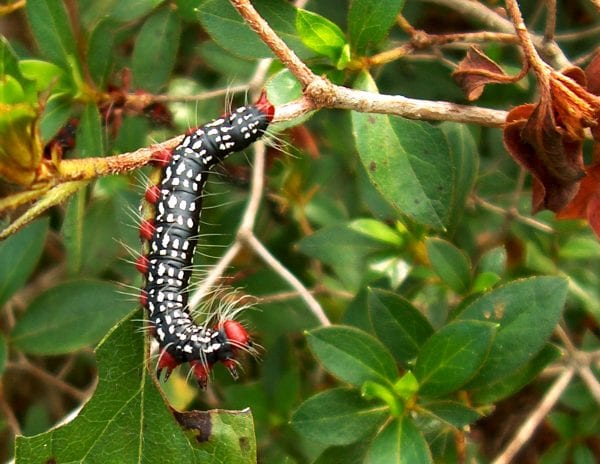
Figure 15. The azalea caterpillar can feed unnoticed, but larger larvae can partially defoliate azaleas in a few days.
Caterpillars are the larval stages of moths and butterflies. These larvae begin their lives as eggs deposited by female moths or butterflies onto the host plant. Once hatched, some can do great damage to a plant. Consider the azalea caterpillar (fig. 15) as an example. The small larvae hatch and feed largely unnoticed. The larger larvae can partially defoliate azaleas in just a few days.
Fortunately, caterpillars have a consistent phenology (sequence of events in the life of an insect). Armed with this information, you can be proactive versus reactive in preventing damage. For example, if you notice damage and large larvae on your azalea bushes in October, make a note to search for caterpillars in mid to late September the following year. Since eggs and larvae are on the plant for a relatively long time, early detection provides opportunities to use cultural controls.
Before you take any measures to eradicate, however, remember that not all caterpillars are bad. Caterpillars that feed on certain ornamental plants (not turfgrass) may be pollinators or butterflies that people wish to attract to their yards. Many are important fat and protein sources for developing birds. In fact, some people will not control caterpillars on their trees, especially in the spring, in order to support local bird populations.
Recognizing some of the common landscape plants that host caterpillar stages of common butterflies may help you understand the importance of plant-feeding caterpillars in pollinator ecology (table 1).
Table 1. Common Host Plants and Butterfly Species
| Butterfly Larvae Host Plants | Butterfly Species |
|---|---|
| American elm | Question mark, painted lady, mourning cloak |
| Black cherry | Spring azure, red-spotted purple, tiger swallowtail, viceroy |
| Black locust | Silver-spotted skipper |
| Pecan | Gray hairstreak |
| Willow | Viceroy, mourning cloak, red-spotted purple, tiger swallowtail |
| Catalpa | Tiger swallowtail |
| Dogwood | Spring azure |
| Mimosa | Spicebush swallowtail |
| Butterfly weed | Monarch |
| Dutchman's pipe | Pipevine swallowtail |
| Oak | Juvenal's duskywing, white hairstreak, banded hairstreak |
| Sassafras | Spicebush swallowtail, tiger swallowtail |
| Passionvine | Gulf fritillary |
| Black-eyed Susan | Silvery checkerspot |
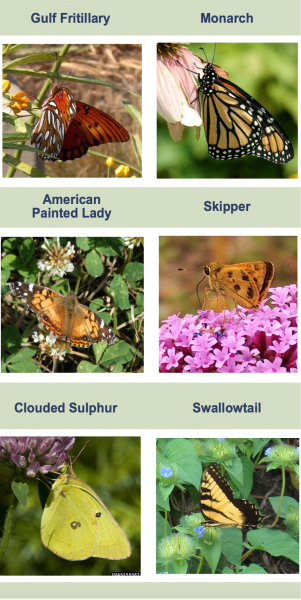
Figure 16. Some caterpillars may be pollinators or butterflies that people want to attract to their yards. Many are protein and fat sources for birds. (Photo credit for monarch and clouded sulphur: David Cappaert, Bugwood.org)
Alternative Insecticides
The insecticides chlorantraniliprole and indoxacarb are effective against caterpillars and provide residual control. Chlorantraniliprole has negligible effects on pollinators and natural enemies. Indoxacarb can be toxic to bees until the spray has dried, after which bee hazard is minimal.
The microbial insecticide Bt (Bacillus thuringiensis kurstaki) also has low toxicity to bees and natural enemies. Chromobacterium subtsugae is a microbial fermentation product that has activity against caterpillars and no harmful effects reported against bees. Foliage of plants treated with Bt or Chromobacterium subtsugae act in the insect stomach and must be consumed by caterpillars to be effective.
The insect growth regulators diflubenzuron and tebufenozide are active against caterpillars. Some limited data suggest that these products may affect learning or bee larvae if bees forage in treated flowers.
Biological Controls
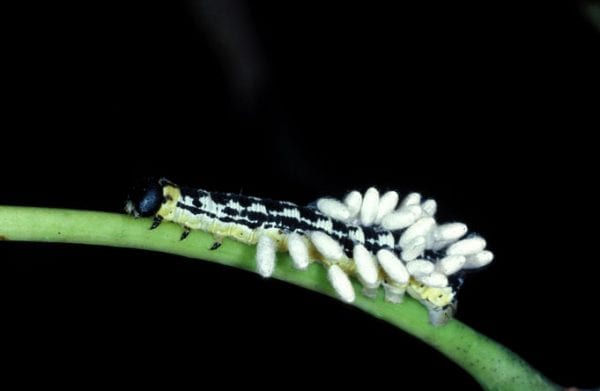
Figure 17. Outward indication of parasitoids developing inside caterpillars. (Photo credit: Lacy L. Hyche, Auburn University, Bugwood.org)
Natural enemies can be important in regulating outbreaks of caterpillars, especially when they are in the egg stage or are small larvae. Natural enemies likely prevent outbreaks from year to year of most native species of caterpillars.
Parasitoids can develop entirely inside caterpillars with little indication that they are active, but you may see some outward sign (fig. 17). Caterpillar predators can be spiders, predatory beetles, and even larger animals such as birds. Birds may aggressively collect caterpillars from trees and shrubs to feed to developing baby birds, particularly in the spring.
Cultural Controls
Cultural controls for caterpillars should include a discussion about the need to control infestations. As noted previously, some larvae will become moth or butterfly pollinators that we ultimately wish to preserve. The question then becomes, do you need to kill them?
Depending on the situation, caterpillar infestations on ornamental plants can be either severe or cause minimal overall damage. As a rule, caterpillars that attack small herbaceous annual and perennial ornamental plants as well as slow-growing evergreen trees and shrubs should be managed. (See Nonchemical Control of Caterpillars on Ornamentals.) Small herbaceous plants and slow-growing evergreen plants (junipers and arborvitae) likely will not be able to recover fully from the loss of leaf tissue. In addition, herbaceous annuals and perennials cannot be treated by many pesticides if they are flowering. Consult the alternative pesticides section for the best options.
The decision to manage caterpillars on deciduous trees may depend on tree size. In older landscapes, trees and shrubs may be too large to spray or treat without specialized equipment.
Larger plants with more leaves can have a significant amount of leaf loss with little impact on growth. In those situations, you can choose to do nothing. Doing nothing, although it sounds passive, is a legitimate IPM strategy. It works for many urban landscape pests, since few pests can kill the large or mature plants on which they are feeding.
In newer urban areas, however, smaller trees are more common. During the first few years after transplanting, defoliation (partial or complete loss of all leaves) can stunt the growth of small trees. It is a good idea to control caterpillars on these trees for the first few years to reduce stunting and possible stresses associated with leaf loss. If you do control caterpillars on small trees, consult the alternative pesticides section for options with fewer hazards to pollinators.
Nonchemical Control of Caterpillars on Ornamentals
Successful cultural control requires accurate insect identification to understand the insect life cycle.
- Hand remove eggs. Remove bagworms in late fall or early winter. These bags are full of eggs and will be the source of larvae in spring.
- Hand remove larvae. In many instances, caterpillars can be removed by hand. Larvae removed and dropped on a driveway or sidewalk or in grass can be food for birds or insect predators. If you do not want to handle larvae, get a small bucket filled with soapy water and tap the branches containing the larvae so that they fall into the soapy water and die.
- Remove nests when they can be safely reached. Do not burn nests in plants. A pair of hand shears or pole pruners can usually effectively remove nests from trees. Once out of the tree, either bag the nest and put it in the trash or submerge it in soapy water to kill the larvae.
- Understand overwintering habits. Canna leafroller caterpillars will consume leaves of canna lily and prevent them from unrolling. At the end of the season, the pupal stage will live in the dry leaves. Cutting and removing these leaves will remove them from overwintering.
- Research before you buy. There are too many ornamental plants for researchers to have resistance evaluations on all of them. Your local Extension agent or garden center, or even an Internet search with the plant and pest name, may provide guidance before you purchase. Here’s an example: No canna lily is resistant to leafrollers, but varieties Maudie Malcolm, Striped Beauty, and Journey’s End generally have fewer larvae out of the 22 varieties evaluated in a field study.
Spider Mites
Spider mites (fig. 18) that attack ornamental plants are often considered among the most difficult pests to control. Most are no bigger than the period at the end of this sentence. Similar to aphids, they have a fast generation time and are located on the underside of leaves. But unlike aphids, spider mites are not insects and can only be effectively managed with certain special pesticides called miticides.
Spider mites, like ticks, have sucking mouthparts that allow them to consume plant sap the way ticks consume blood. But not every mite found on ornamental plants is a pest. There is a group of mites that is predatory to pest mites. They are so similar in size and appearance to pest mites that only well-trained individuals using a microscope can distinguish the beneficial predators from the pests.
- Figure 18. Tiny spider mites attack ornamental plants and are difficult to control.
- Figure 19. Spider mite webbing is tighter on the plant than is spider webbing. Spider mites can be seen actively crawling on the webbing.
One way you can determine the difference is through observation. Spider mites are often associated with damage called stippling and sometimes webbing. Stippling is a symptom of feeding by spider mites, but it also can be associated with lace bugs and certain leaf-hoppers. Feeding with sucking mouthparts enables these pests to remove the contents of plant cells, resulting in empty cells filled with air (stippling) or yellow, chlorotic areas. Webbing (fig. 19) is more often associated with spiders, but spider mite webbing is often tighter on the plant. Spider mites will be actively crawling on the webbing if they are the cause.
Alternative Insecticides
Miticides vary considerably in their effects on pollinators. The internet has made many general-use pesticides and miticides more widely available to homeowners, but many products may still be too expensive for home use.
Products such as insecticidal soap are widely available from local retailers under several different trade names. Soaps may cause burning or phytotoxicity on certain plants, so be sure to read the label for specific guidelines.
Spider mites have an interesting response to certain insecticides—their populations increase. An increase in spider mite populations following insecticide use (often called flaring) is traditionally associated with insecticides such as carbaryl and acephate. Recent studies also indicate that the neonicotinoid insecticide imidacloprid can flare spider mite populations.
One study in New York City’s Central Park noted greater mite populations on elm trees treated with imidacloprid for another pest. The insecticides change the plants in a way that improves the survival of mites or causes females to produce more eggs than females on untreated plants. For this reason, use caution when using carbaryl, acephate, or imidacloprid for plant pests where mites may also be present.
Biological Controls
Predatory mites are one of the most common groups of natural enemies to spider mites. For this reason, the presence of mites on plants may not warrant treatment. Predatory mites and pest mites cannot be distinguished with the unaided eye. If you want to know if mites are beneficial or pests, you should submit a sample to the plant diagnostic labs at your state land grant university for an accurate identification (see Additional Resources for contact information). Other predators include lacewing larvae, some thrips, and lady beetle larvae, which are larger and easier to recognize.
It is important to note that certain pesticides can reduce the numbers of predatory mites and cause greater problems with spider mites. Mite populations are also naturally susceptible to a number of diseases. Spider mites may be less abundant during humid or wet times of the year. During hot and dry weather, you may want to check plants more regularly for stippling or webbing.
Cultural Controls
Mites are more frequently diagnosed on low-growing plants where webbing or stippling is easily observed. Mite infestations in trees or larger shrubs are often more difficult to detect and sample. In small plants with heavy infestations of mites, it is sometimes easier to get rid of the plant and start over rather than repeatedly applying pesticides.
Japanese Beetles
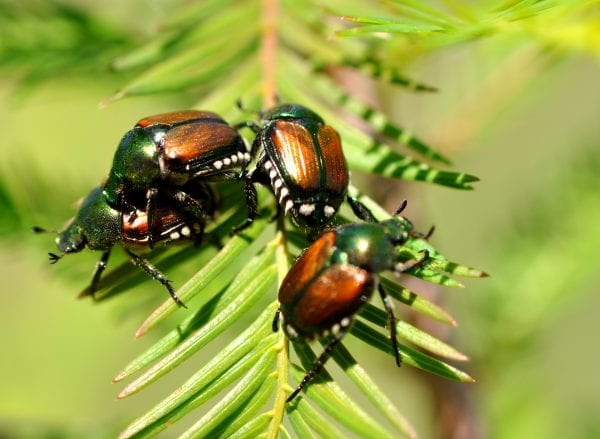
Figure 20. Japanese beetles are the adult stage of a common white grub found in turfgrass. Grubs develop in the soil and emerge as adult Japanese beetles.
Japanese beetles are the adult stage (fig. 20) of a common white grub found in turfgrass. The grubs develop in the soil and then emerge as adult Japanese beetles. The adults can feed on hundreds of species of ornamental plants. They are most commonly found on roses, crabapples, and crapemyrtles.
These beetles are active from late May through July in most of the Southeast. The first beetles usually appear with first bloom of the common white crapemyrtle variety. It is important to control or remove early-arriving beetles, because plants damaged by Japanese beetles are more attractive to other Japanese beetles. They are typically controlled by insecticides applied to the foliage or by systemic insecticides applied to the roots or injected into the tree trunks by professional arborists.
Alternative Insecticides
Japanese beetles are such an important landscape pest that considerable research on alternative controls has been conducted. The main objective has been to evaluate the length of residual control or protection from a single application.
Products containing the active ingredient azadirachtin are quite variable in their effects. These products can be used on plants not in flower or on flowering plants only when bees are not present. Depending on the product, you can expect as few as 1 to 3 days of residual or as many as 14 days of protection from one application.
Unfortunately, not all alternative products are effective at preventing damage. Field or laboratory evaluations of products containing garlic extract, d-Limonene, capsaicin, kaolin clay, and rotenone + pyrethrin show no benefit in protecting treated plants from Japanese beetle feeding. A canola oil + natural pyrethrin-based product can provide a few days of protection but must be reapplied regularly to prevent damage.
Biological Controls
Japanese beetles are not native to the United States, which means there are a limited number of natural enemies. Since their introduction in 1916 from Japan, several attempts have been made to import natural enemies. In certain areas, a small fly imported to the United States will lay an egg on an adult, eventually killing it. This has had a negligible effect on the spread and pest status of Japanese beetles. There are many anecdotal observations of birds, ants, toads, spiders, and other animals consuming adult Japanese beetles, but there is little published data on the impacts on populations.
Cultural Controls
Cultural control methods for Japanese beetles are mixed with successes and failures. Among the less effective are traps, which come in various sizes, shapes, and names. These were developed by the USDA as a means to collect insects for survey purposes. In urban landscapes, however, they do very little to reduce damage if used in close proximity to host plants.
Organic gardening literature contains planting schemes that are supposed to discourage Japanese beetles from attacking plants such as roses. Many of the plants promoted are aromatic, like rue or garlic, and others are allegedly toxic to Japanese beetles. In research studies, the common schemes evaluated failed to protect roses in garden plots, and some actually increased damage.
The practice of hand removal or removing blooms from roses has been suggested in many Extension publications. Hand removal exploits a biological anomaly in beetle biology. Japanese beetle adults cannot fly when their body temperatures are below 81 degrees F. In northern areas, overnight temperatures make the beetles sluggish in the morning. If this occurs, they drop from plants rather than fly. Insects that drop from a plant can be captured in a bucket of soapy water and killed. The problem with this approach in the Southeast is that many nights during beetle flight do not get below 75 degrees F and quickly warm to 80 degrees F or more shortly after sunrise. This limits beetle removal as a tool throughout most southern states.
A research study in Indiana indicated some benefit to hand removal or removal of blooms from roses as a means to prevent damage. Hand removing damaged rose blooms may help to limit new beetles from finding and doing more damage to those plants.
Host plant resistance is one cultural control that does work. The idea is simple: Find plants that Japanese beetles will not eat and grow those species or cultivars. This may seem difficult with an insect that consumes greater than 300 species of plants, but significant resistance has been found among cultivars of crapemyrtle, lindens, elms, and crabapple trees. Unfortunately, no meaningful resistance is noted among roses. These beetles seem to prefer rose blooms that are yellow or white. Your local Extension office can assist you with ideas for plants that grow in your area that are not susceptible to Japanese beetles. Interestingly, zonal and ivy geranium flowers are toxic to adult Japanese beetles. If beetles consume just one petal of these flowers, they experience paralysis that often leads to death in the summer heat. Some gardening magazines have suggested that geraniums can be planted among plants such as roses for protection, similar to marigolds in a vegetable garden. But research studies have shown that planting geraniums with roses actually increases the number of beetles on the roses they are supposed to protect.
The latest cultural control device is one that actually shakes the plant (http://bugvibes.com/products.html) to dislodge the beetles (fig. 21). Unpublished data suggest this treatment may be useful to dislodge beetles from plant foliage, but beetles feeding in the blooms of plants such as roses can remain.
- Figure 21. The latest cultural control device shakes the plant to dislodge the beetles. (Photo credit: R. C. Williamson, University of Wisconsin–Madison)
- Figure 22. Thrips are among the smallest insects that attack plants. Females insert eggs into plant leaves or flowers. The eggs hatch and the immature stages feed alongside the adults. Populations can build quickly.
Thrips
Thrips (fig. 22) are among the smallest of the insects that attack plants. They are in the insect order Thysanoptera, which includes plant feeders, fungal feeders, and some predators. Thrips are slender insects with frail wings that don’t allow them to fly very well. The adults are mostly female; most insert their eggs into plant leaves or flowers. The eggs hatch and the immature stages feed alongside the adults. These insects can develop from egg to adult in a week, which allows populations to build quickly.
When thrips feed, they poke small holes in the plant and suck the sap. Damage by thrips can cause flowers to discolor or drop. Foliage often has a silvery appearance resulting from this unique feeding style.
In landscapes, thrips are mostly found in flowers and can be seen with the unaided eye by taping a flower on a blank piece of white paper. If present, thrips will appear as yellow to light brown slender insects moving quickly on the paper. Mites, similarly small arthropods, will appear more rounded than thrips. Thrips also are attracted to yellow and blue colors and can be sampled with sticky cards. It is challenging to see these small insects on the card, but the technique is effective.
Alternative Insecticides
Thrips management, even when using insecticides, is complicated by their small size and ability to hide.
Treatment of flowers with insecticide can be difficult. Petals and other flower parts make it challenging to get good coverage, plus the potential for injury to flowers may limit what products can be used.
Chromobacterium subtsugae and Isaria fumosorosea, microbial-based products labeled for thrips, can be applied even to flowering plants. Neem-based insecticides can be used as feeding deterrents to adults and have growth regulator properties against the immature stages. Insecticides containing spinosad also are effective for thrips. Insecticidal soaps can be used with caution due to potential damage to flowers. Read and follow the label to prevent injury. Most spinosad and neem products should be used when bees are not present. Insecticidal soaps can be applied anytime with reasonably low hazard to pollinators.
Biological Controls
Thrip predators are small, like their prey. One group, called minute pirate bugs, can also be seen when you sample plants for thrips. They are small but will appear wider and darker than most pest thrips. Some species of wasps parasitize thrips. As they complete development inside the thrips, they cause a mummy-like appearance. General predators such as lady beetles and lacewings can also be effective predators. Certain pathogens, including some microbial insecticides and insect parasitic nematodes, are effective controls for thrips.
Cultural Controls
Cultural controls for thrips are limited. Most pest thrips have a wide range of plants they can use as food. For this reason, weedy gardens can allow thrips populations to build up. Once populations destroy or outgrow the weeds, they will move into your flower and vegetable gardens.
IPM for Common Pests of Lawns
The usefulness and necessity of home lawns is currently being debated by conservation and environmental groups. While the debate continues, families still rely on home lawns as a place for recreation and social activities. Many municipalities require lawns or a similar ground cover on lots in planned communities or subdivisions.
Pollinators are not particularly associated with lawns, except when flowering weeds are present. Weeds such as dandelion and clover can host as many as 100 species of pollinators. The decisions you make concerning lawn care need to include consideration of how pest management can affect pollinators.
Following are some best management practices to protect and conserve pollinators associated with urban lawns:
- Remove flowering lawn weeds before any pesticide application to the lawn. Mowing is probably the fastest way to do this.
- Avoid insecticide applications when pollinators are present. Use insecticides that have no known adverse effects if pollinators are present.
- When recommended on the label, make sure insecticides receive irrigation after application.
- Use granular formulations when possible.
- Do not apply pesticides in conditions that would allow them to drift onto flowering ornamental plants.
- Make sure your equipment is properly calibrated and delivering a rate prescribed by the label.
- Read and follow the label whenever applying pesticides.
White Grubs
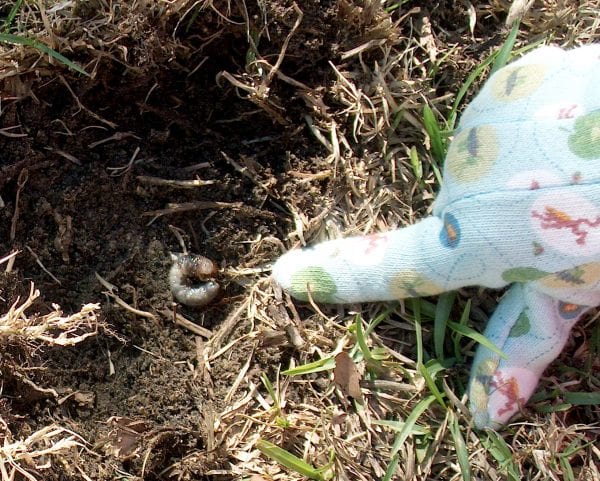
Figure 23. White grubs are the immature stages of different types of beetles. They feed on the roots of grasses or lawn weeds.
White grubs (fig. 23) are the immature stages of different types of beetles. Most white grubs develop over a year, feeding on the roots of grasses or lawn weeds. Usually in the spring or early summer, adults emerge from the ground, mate, and return to the soil to lay eggs, repeating the cycle. This period of adult activity and egg laying is typically used to time insecticide applications.
A small grub hatches from each egg in about 10 to 14 days. Some of these beetles, such as Japanese beetles, are also pests, eating mainly the leaves of trees and shrubs and returning to soil to lay eggs. For these species, having host plants for the adult stage in the landscape also may increase grub populations if there is good grass nearby. It is still a mystery how females choose their place to lay eggs, but they don’t necessarily have to return to the same place year after year.
Because white grubs are in the soil, it is often labor intensive to check for them. A spade or shovel is typically used to dig small holes in the turf, and the soil is broken apart to expose the roots. If present, white grubs will be in the root areas. White grub populations are localized in patches, so sample multiple places.
Research using cool-season lawn grasses (e.g., fescue or ryegrass) suggests a healthy lawn should tolerate fifteen or more white grubs per square foot. Drought-stressed or poorer-quality lawns (due to improper care) tolerate fewer grubs. Fescue and warm-season grasses such as bermudagrass are also more tolerant of white grub feeding.
The difficult task of sampling for grubs may have contributed to quick adoption of long-term residual soil insecticides such as neonicotinoids, which can be applied in late spring and provide protection against grub infestations in summer. The concern over pollinator impacts of neonicotinoids in urban landscapes is one reason for this publication.
If you don’t want to sample your soil, you can still determine if you have white grubs. Remember, white grubs are actively consuming roots of the grasses. Lawns where grubs are present will appear to be yellowing, despite watering; large brown areas can even form if not checked. At this advanced stage, the grass has very little root mass to get water and nutrients.
In lawns with bermuda, centipede, St. Augustine, or zoysiagrass, you still need a shovel to check for grubs. In fescue or ryegrass lawns, however, you can pull on the turf in these areas and it will roll back like a rug, revealing the insects. Grub-infested patches also may be visited by digging animals such as skunks, raccoons, and armadillos. In many cases, animals digging for white grubs cause more damage than the grubs themselves.
A common question is, if white grubs are not controlled in the fall, will they cause damage in the spring? White grubs will feed on grass roots in the spring to complete their development, but damage is less likely. This may be due to greater rainfall and lower temperatures in spring.
Alternative Insecticides
White grubs are one of the primary targets for neonicotinoid insecticides in urban landscapes. Chlorantraniliprole insecticide is a highly effective alternative to neonicotinoids for white grub control. A discussion of other insecticides that are biological follows.
If you are opposed to using insecticides for white grub control, consider replanting your grass. A bag of seed may be equal in cost to a bag of insecticide.
Biological Controls
Several products containing a specific strain of the soil bacterium Bacillus thuringiensis (Bt) are labeled for white grubs. These are compatible with pollinator protection. Be aware, however, there are strains of Bt that do not control white grubs. In general, Bts labeled for control of caterpillars or mosquito larvae do not work on white grubs and vice versa.
The bacterium Paeinbacillus papilliae, responsible for milky spore disease, has been mentioned as a biological solution for white grubs in lawns. This bacterium is still available commercially, but university tests have failed to show it can provide adequate control of white grubs.
Entomopathogenic nematodes can be exceptionally effective against white grubs if applied correctly. These nematodes do not infect plants, just insects. The primary limitation to using nematodes for white grub control is cost. Application rates are such that one application of entomopathogenic nematodes costs four times or more the cost of an insecticide.
There are many insect predators and parasites that are effective in reducing problems with white grubs. Predatory arthropods include ants, spiders, and various beetles. These predators attack eggs as well as small grubs in the soil.
Wasps that attack white grubs are rather amazing. To find a grub, they actually tunnel in the ground, searching in the dark. These wasps sting a white grub when they find it, lay an egg on it underground in the dark, then find their way back to the surface.
There are several species of wasps in the genus Tiphiathat that attack the grubs of Japanese and chafer beetles.
Scolia dubia is a large parasitic wasp of green June beetles that is common on flowering plants in the fall. There is limited evidence to suggest that adding certain plants to a landscape may promote activity of these wasps. For example, spring-active Tiphia wasps use nectar from peony flowers and stay around to attack Japanese beetle grubs if present. The attacks by these wasps are local, meaning flowering peonies must be within about 5 feet of the area in the lawn to be effective.
Cultural Controls
Several studies have evaluated the responses of different grasses to white grubs. Bermudagrass and other grasses that have greater root mass or more rapid root growth seem to tolerate white grub feeding. Cool-season grasses (fescue or ryegrass) during the heat of summer have less root mass and tend to readily show damage from white grubs. Grasses that are irrigated or in areas with average to above-average rainfall tend to tolerate white grubs since the grasses are under less water stress.
Studies also have evaluated tines or spikes, either on golfing shoes or grass aerification equipment, as a mechanical control. In these studies, there was a reduction in white grubs in grasses that had multiple passes with a tine aerifier or spiked shoes. Overuse of these techniques, however, can also be extremely damaging to the turfgrass.
Mole Crickets
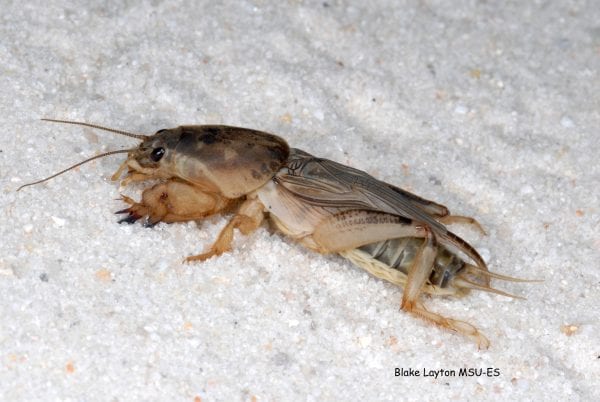
Figure 24. Mole crickets tunnel in the ground and feed on plant parts and other insects. As they tunnel underground, they make small mounds and tunnels just below the surface.
Mole crickets (fig. 24) spend virtually their entire lives tunneling in the ground and feeding on plant parts (roots, seedlings, grass blades) as well as other insects. As they tunnel underground, they make small mounds and tunnels just below the surface. They create holes (like swiss cheese) that can dry out the soil and make it difficult for grass to survive.
Insecticides applied to the ground as sprays, granules, or baits are the primary way to control these insects and avoid damage. Insecticides are usually applied when the eggs hatch to prevent damage. While this can provide control, eggs may hatch later, or new eggs may be deposited requiring additional applications.
For a thorough review of the biology and management of mole crickets, see “Biology and Control of Mole Crickets” (Extension publication ANR-0176).
Alternative Insecticides
Fipronil and pyrethroids are among the two main insecticide groups applied to mole crickets. There are few alternatives. If insecticides must be used, baits or granular forms are less hazardous to pollinators than are liquid insecticides.
Biological Controls
Insect parasitic nematodes do not infect plants as do plant parasitic nematodes. Steinernema scapterisci, an insect parasitic nematode, was discovered by the University of Florida and marketed commercially, but it appears to be no longer available. Other nematodes, Steinernema carpocapsae and Heterorhabiditis bacteriophora, are commercially available for control of many turfgrass pests, including mole crickets.
Insect parasitic nematodes attack adult or older nymph stages of mole crickets if applied in the spring. They are typically applied in the early morning or late in the day to avoid the heat, which may kill these nematodes. Nematodes are applied at rates of billions of infective juvenile stages per acre. At these high numbers, application costs are generally greater than for conventional insecticides. Some also may require pretreatment irrigation followed by post-treatment irrigation. See specific product labels for complete directions.
Successful infection of mole crickets doesn’t necessarily eliminate all damage from them. For this reason, insect parasitic nematodes provide a biological option to suppress mole crickets for homeowners that may want organic or nonchemical controls.
Certain insects also can kill mole crickets and help to reduce the population. These are not available commercially, but they may be released and established as part of state or regional IPM programs.
The most common insect natural enemies are Larra bicolor wasps, ground beetles, and southern mole crickets, which eat other mole crickets. Larvae of the Pheropsophus aequinoctialis ground beetle attack mole cricket eggs. Sirthenea carinata, a predatory bug, also will attack mole crickets. Armadillos and birds may dig in grass and eat them. While digging for mole crickets, birds and armadillos often do more damage than the crickets.
Cultural Controls
Grass resistance to mole crickets has been reported in many southern grasses used in lawns. For example, TifSport hybrid bermudagrass and Emerald, Cavalier, and Palisades zoysiagrasses are tolerant of tawny mole crickets, while Meyer zoysiagrass and most types of bahiagrass are very susceptible.
Southern Chinch Bugs
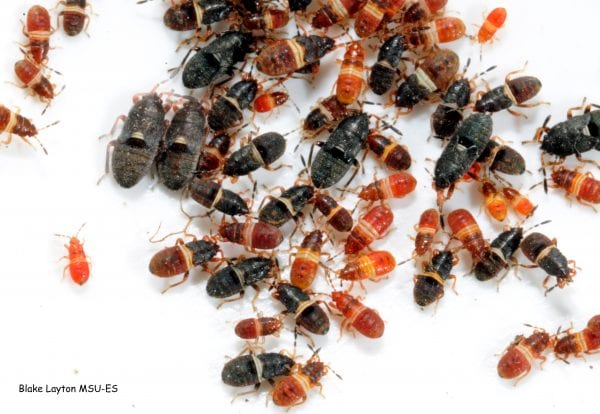
Figure 25. Southern chinch bugs damage different types of grasses and can be active year-round in coastal areas of the United States.
Southern chinch bugs (fig. 25) are the most important pest of St. Augustinegrass. They occasionally cause damage to bermudagrass, centipedegrass, and zoysiagrass lawns.
Adults as well as immature stages of southern chinch bugs feed on stems, crowns, and stolons of grasses, causing the plants to yellow and die. They can be active year-round in the coastal areas of the Southeast. In winter, only the adult stages typically remain.
Chinch bugs complete three or more generations per year. They tend to feed in aggregations, sucking sap from the grass. During feeding, they inject saliva that contains toxins that can contribute to grass wilting and discoloration. Damage usually occurs in sunny spots, even if the rest of the lawn is partially shaded.
Alternative Insecticides
Unfortunately, southern chinch bugs in Florida and elsewhere in the Southeast have developed resistance to many common insecticides. This has limited the availability of alternative insecticides.
Biological Controls
There are several insect natural enemies of southern chinch bugs, but these are endemic and not available for purchase and release. The two most common predators are spiders and an insect called big-eyed bug.
Big-eyed bugs superficially resemble southern chinch bugs. If you are unsure about identification of either big-eyed or chinch bugs, take a sample of your lawn or the insects to your local Extension office for a correct identification.
Cultural Controls
Grasses resistant to southern chinch bugs are one of the most successful examples of host plant resistance in turfgrass. Captiva and Floratam are two varieties of St. Augustinegrass in that category. In some areas of Florida, however, Floratam may no longer be resistant to chinch bugs. Lawn fertilizer also can cause problems. Overapplication of nitrogen fertilizer can cause outbreaks of chinch bugs to be worse.
Caterpillars
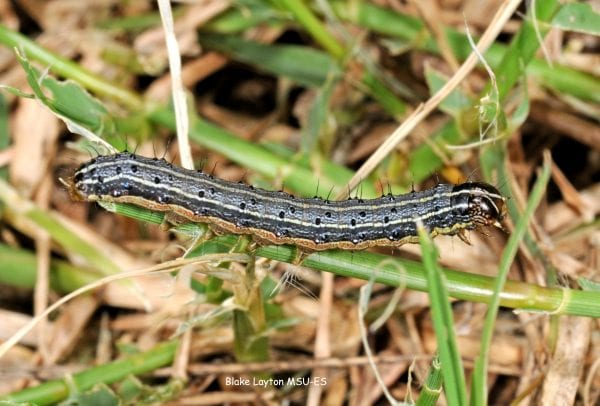
Figure 26. Fall armyworms are among the most common caterpillar pests of southern lawns.
Caterpillars are the immature stages of moths. Fall armyworms (fig. 26) and tropical sod webworms are among the most common caterpillar pests of southern lawns. Adult moths deposit eggs on or near turfgrass where the caterpillars are found.
Caterpillars often are not seen in lawns until they are large. As they increase in size, so does the amount of grass they consume. When not feeding, they usually hide in the thatch to rest, making them undetectable. A soap solution made with 2 tablespoons of liquid dishwashing soap mixed in 1 gallon of water can be poured over a 1- to 2-square-foot area. If caterpillars are present, they will come to the surface. Both armyworms and webworms produce multiple generations per year, but outbreaks tend to be sporadic.
Alternative Insecticides
Insecticides with the active ingredient chlorantraniliprole, indoxacarb, or spinosad are effective against caterpillars. Chlorantraniliprole has negligible effects on pollinators. Indoxacarb and spinosad can be toxic to bees until the spray has dried, after which the bee hazard is minimal.
The microbial insecticide Bt (Bacillus thuringiensiskurstaki) also has low toxicity to pollinators. Chromobacterium subtsugae is a microbial fermentation product formulated like an insecticide that has activity against caterpillars with no reported harmful effects to bees. Plant foliage treated with Bt or C. subtsugaeact in the insect’s stomach and must be consumed by caterpillars to be effective.
Biological Controls
Birds, ants, predatory beetles, and even paper wasps are effective predators of caterpillars. For golf course managers, activity of these birds or wasps is often the first indication that caterpillars are present. While these predators may not control an existing outbreak, they often prevent many outbreaks from ever occurring.
Insect parasitic nematodes Steinernema carpocapsae and Heterorhabditis bacteriophora are some of the few natural enemies that can be purchased and used for biological control of caterpillars in turfgrass. Insect parasitic nematodes do not infect plants as do plant parasitic nematodes. Carefully follow label directions when applying.
Biological Controls
Bermudagrass is the most common lawn grass attacked by lawn caterpillars. Grass fertility can influence egg laying and caterpillar feeding. Overfertilized grasses are more often selected by armyworm moths and can help caterpillars grow faster.
Conclusion
The proper identification of plant pests when they occur is important. Damage to leaves of trees and shrubs may persist after an insect is gone. Your county Extension office as well as landscape professionals in your area can assist with diagnosis of plant problems. Many pests will have the same seasonal appearance or phenology each year, so this may help with identification and IPM efforts.
The best way to ensure pollinator safety and avoid excessive damage from insect pests is to first use noninsecticidal IPM methods to reduce the frequency and intensity of pest outbreaks. When damaging outbreaks occur that require insecticide treatment, choose products, formulations, and methods of application that limit adverse impacts to pollinators. Closely follow the labeled rates and directions, giving special attention to the directions on the timing of applications.
Additional Resources
Plant Diagnostic Laboratory, Alabama Cooperative Extension System
http://enpp.auburn.edu/outreach/plant-diagnostic-laboratory/
Mississippi State University Extension
http://extension.msstate.edu/insects/insect-identification
Plant Diagnostic Center at Louisiana State University
Protecting Pollinators in Urban Areas Series
- “Pollinator Ecology,” ANR-2409
- “Use of Flowering Plants,” ANR-2419
- “Reducing Hazards from Pesticide Use,” ANR-2420
- “Safe Use of Integrated Pest Management,” ANR-2387

